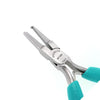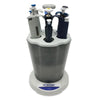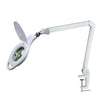- No products in the cart.
Compound Microscopes vs. Stereo Microscopes: What’s the Difference?
Apr
07
2022
Microscopes are one of the most important pieces of equipment in science classrooms, research laboratories, and medical facilities. They allow students and professionals to see enlarged images of objects so that they can be examined in more detail.
There are two microscopes that are commonly used. These two include the stereo microscope and the compound microscope. Both of these microscopes serve the same purpose when it comes to magnifying objects but they are each designed for different applications.
What is a Compound Microscope?
A compound microscope is used to view something that you can’t see with the naked eye. It does this by magnifying the image of the object or sample so that it can be studied in detail. This type of microscope uses backlit slides and multiple lenses to view samples at higher magnifications. The one visual path relays the identical image back to the left and right eye.

A compound microscope is often used to study bacteria and cells. They are primarily used to study the internal structure of specimens by using high magnification. These microscopes usually consist of three or four lenses. These lenses usually project magnifications of up to 100x. When you add the eyepiece that magnifies up to 10x, you can get magnifications of up to 1000x.
Compound microscopes have a compact working distance that ranges up to 4 mm. This makes these microscopes more effective when being used in applications that use very thin samples that are transparent and that light can pass through.
What is a Stereo Microscope?
Stereo microscopes, also known as dissecting microscopes, are used to examine opaque, larger, and 3D objects. These microscopes are designed with two lenses and eyepieces, one for each eye. The two separate optical pathways provide a perception of depth for a three dimensional view. Stereo scopes are ideal when using applications that involve viewing larger objects that need to be manipulated while being observed.
Stereo microscopes are used at lower magnifications. They are also designed with a big working distance to study objects that can be seen by the naked eye. Stereo scopes are often used to examine electronic parts, plant life, and insects which make them a popular choice for industrial and biological labs.
Differences Between a Compound Microscope and a Stereo Microscope
While both the compound microscope and stereo microscope magnify objects and samples so that they can be examined in more detail, there are some stark differences between the two.
The main difference is that they are designed for different applications. The compound microscope is generally used to examine samples that can’t be seen with the naked eye such as cells and bacteria. The stereo microscope is often used to view larger objects that can be seen with the naked eye such as electronic parts and plant life.
The two microscopes are different when it comes to their magnification capabilities. While both microscopes magnify objects, the compound microscope uses much higher magnification than the stereo microscope. Compound scopes have a magnification of up to 1000x or greater.
Due to the different design of the two microscopes, they each project a difference in depth perception. Due to the one optical path in the compound microscopes that relay the same image back to both eyes, the projection of the object appears two dimensional. However, with the stereo microscope that is designed with two lenses and eyepieces, the projection of the object appears three dimensional.
There are differences between the working distance of the two microscopes as well. Compound microscopes have a small working distance which makes them more practical when examining ultra-thin and transparent samples. Stereo microscopes, on the other hand, have a larger working distance which makes them ideal for examining larger opaque objects. The advantage to the larger working area of the stereo microscope is that you can manipulate the object while it is being observed.
The two microscopes are also designed with different parts to be more compatible with the different applications. The compound microscope is more likely to have a condenser and iris diaphragm than the stereo microscope. The condenser’s purpose is to direct light onto the specimen while the iris diaphragm regulates the amount of light. Objectives consist of lenses that collect light from the sample. In compound microscopes, the objectives can be replaced, cleaned, or removed. In stereo microscopes, the objectives are fixed in place. When using compound microscopes, the samples are placed on a glass slide with a coverslip to hold the specimen in place. Since stereo microscopes are typically used to view larger objects, slides and coverslips can’t be used.














































